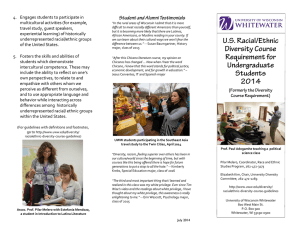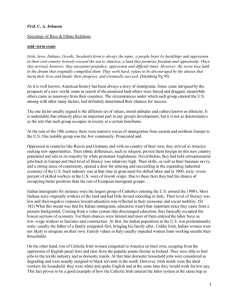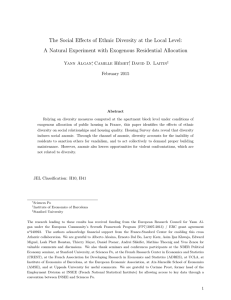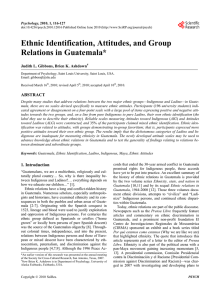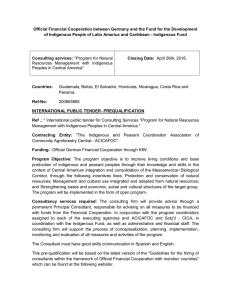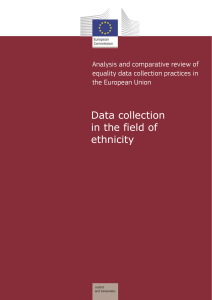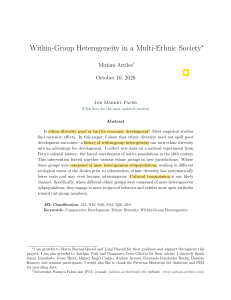Ethnic Identity among Indigenous and Mestizos
Anuncio
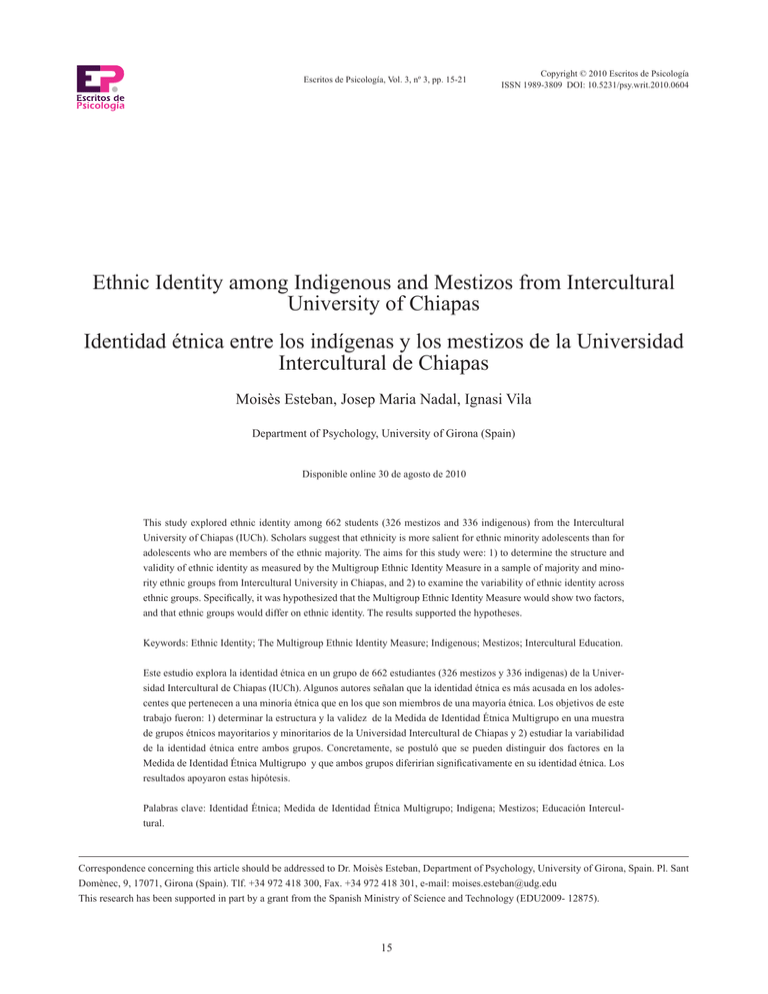
Escritos de Psicología, Vol. 3, nº 3, pp. 15-21 Copyright © 2010 Escritos de Psicología ISSN 1989-3809 DOI: 10.5231/psy.writ.2010.0604 Ethnic Identity among Indigenous and Mestizos from Intercultural University of Chiapas Identidad étnica entre los indígenas y los mestizos de la Universidad Intercultural de Chiapas Moisès Esteban, Josep Maria Nadal, Ignasi Vila Department of Psychology, University of Girona (Spain) Disponible online 30 de agosto de 2010 This study explored ethnic identity among 662 students (326 mestizos and 336 indigenous) from the Intercultural University of Chiapas (IUCh). Scholars suggest that ethnicity is more salient for ethnic minority adolescents than for adolescents who are members of the ethnic majority. The aims for this study were: 1) to determine the structure and validity of ethnic identity as measured by the Multigroup Ethnic Identity Measure in a sample of majority and minority ethnic groups from Intercultural University in Chiapas, and 2) to examine the variability of ethnic identity across ethnic groups. Specifically, it was hypothesized that the Multigroup Ethnic Identity Measure would show two factors, and that ethnic groups would differ on ethnic identity. The results supported the hypotheses. Keywords: Ethnic Identity; The Multigroup Ethnic Identity Measure; Indigenous; Mestizos; Intercultural Education. Este estudio explora la identidad étnica en un grupo de 662 estudiantes (326 mestizos y 336 indígenas) de la Universidad Intercultural de Chiapas (IUCh). Algunos autores señalan que la identidad étnica es más acusada en los adolescentes que pertenecen a una minoría étnica que en los que son miembros de una mayoría étnica. Los objetivos de este trabajo fueron: 1) determinar la estructura y la validez de la Medida de Identidad Étnica Multigrupo en una muestra de grupos étnicos mayoritarios y minoritarios de la Universidad Intercultural de Chiapas y 2) estudiar la variabilidad de la identidad étnica entre ambos grupos. Concretamente, se postuló que se pueden distinguir dos factores en la Medida de Identidad Étnica Multigrupo y que ambos grupos diferirían significativamente en su identidad étnica. Los resultados apoyaron estas hipótesis. Palabras clave: Identidad Étnica; Medida de Identidad Étnica Multigrupo; Indígena; Mestizos; Educación Intercultural. Correspondence concerning this article should be addressed to Dr. Moisès Esteban, Department of Psychology, University of Girona, Spain. Pl. Sant Domènec, 9, 17071, Girona (Spain). Tlf. +34 972 418 300, Fax. +34 972 418 301, e-mail: [email protected] This research has been supported in part by a grant from the Spanish Ministry of Science and Technology (EDU2009- 12875). 15 MOISÈS ESTEBAN, JOSEP MARIA NADAL, IGNASI VILA Ethnic identity is recognized increasingly as a critical component of the self-concept, like other aspects of identity, and there is wide agreement that ethnic identity is crucial to the psychological well-being of members of an ethnic group (Roberts, Phinney, Masse, Chen, Roberts & Romero, 1999; Umaña-Taylor & Updegraff, 2007). In particular, the American Psychological Association (APA) has encouraged “psychologist to psychologist to recognize ethnicity and culture as significant parameters in understanding psychological process” (APA, 2002, p. 3)”. However, there has been little consensus on exactly what ethnic identity is or how it should be measured (Phinney & Ong, 2007). Moreover, the role that higher intercultural educative context plays in ethnic identity of majority and minority ethnic groups has received little attention. The purpose for the present study was to clarify the construct of ethnic identity through examination of the structure and validity of a widely used measure of ethnic identity (Phinne, 1992) among students from diverse ethnic groups that attend an intercultural context of education in Chiapas that had never been studied before. group, with strong attachment. By exploration we mean the process of seeking information, knowledge, and experiences relevant to one’s ethnicity. Therefore, the evidence concerning to the factor structure of MEIM scores is mixed, with researchers reporting one, two and three factor solutions for ethnic identity (Dandy et al., 2008). According to Tajfel’s theory, ethnic identity the same as other social categories (i.e. religion, nation, and so on), is particularly an important aspect of identity for minority people because in the process of becoming a member of both their own group and of the mainstream society they have to explore the values of the host society and those of their own ethnic, religion or cultural group. In other words, they have to deal with the additional burden of having a dual reference point (Tajfel, 1978). In line with this reasoning, Phinney (2003) proposes that most ethnic groups must resolve two basic conflicts that occur as a result of their membership in a nondominant group. Firstly, non-dominant group members must resolve the stereotyping and prejudicial treatment of the dominant population toward non-dominant group individuals, thus bringing about a threat to their self-concept. Secondly, most minorities must resolve the clash of value systems between non-dominant and dominant groups and the manner in which minority members negotiate a bicultural value system. Ethnic identity has been defined in many ways. Some writers consider self-identity the key aspect; others emphasize feelings of belonging and commitment, the sense of shared values and attitudes or attitudes toward one’s group (Phinney, 1990; Phinney & Ong, 2007). Phinney and Alipuria (1990, p. 36) define ethnic identity as “an individual’s sense of self as a member of an ethnic group and the attitudes and behaviors associated with that sense”. This definition suggests three components of the ethnic identity. Phinney and Alipuria (1990), in a seminal work, showed that ethnic identity issues were significantly higher among minority group (Asian-American, Black, and MexicanAmerican) compared to majority group (White people and college students). Other empirical studies, with different samples, supported this hypothesis (Dandy et al., 2008; Phinney, 1992; Smith, 2002; Verkuyten, 2002). Social identity theorists maintain that, especially when people from subordinated groups perceive illegitimate and fixed intergroup status differences they have to counteract negative social identity and they will therefore tend to stress ethnic identity through a process of reaffirmation and revitalization (Tajfel, 1981). Based on psychological literature and on empirical data, Phinney (1992) identified three ethnic identity components: 1) Affirmation of beliefs and belonging that derive from Tajfel’s social identity theory; 2) Exploration and commitment, with roots in Erikson’s identity development theory; and 3) Ethnic behaviors or practices from Berry’s acculturation theory. In this sense, Phinney’s pioneering work (1992) proposed a global measure of ethnic identity (Multigroup Ethnic Identity Measure, MEIM) based on young adults and adolescents containing three connected sub-dimensions of ethnic identity. However, a re-examination of the factorial structure with a large sample of adolescents identified two distinct but connected dimensions: Affirmation (as well as sense of belonging) and Exploration (Roberts, Phinney, Masse, Chen, Roberts & Andrea, 1999). This finding is consistent with other works (Dandy, Durkin, McEvoy, Barber & Houghton, 2008; French, Seidman, LaRue & Aber, 2006; Pegg & Plybon, 2005) but inconsistent with other studies (Lee & Yoo, 2004). According to two factors solution (Roberts et al., 1999) the MEIM evaluated two distinct but connected dimensions. By affirmation we mean the sense of identification as a member of a particular social The ethnic identity issue is meaningful only in situations in which two or more cultural groups are in contact. In a culturally homogeneous society, ethnic identity is not a useful concept (Phinney, 1990). It is evident, then, that all studies of this topic compared minority groups versus majority groups. However the MEIM was developed to be used with ethnocultural minorities in the USA (Phinney, 1992). There is a need to investigate the measure in other multicultural contexts and with different minority groups. In particular, no prior published research has investigated the measurement of ethnic identity in indigenous and mestizos from Chiapas (México) that attend to an intercultural university. 16 ETHNIC IDENTITY IN CHIAPAS The aims for this study were: 1) to determine the structure and validity of ethnic identity as measured by the MEIM in a sample of majority and minority ethnic groups from Intercultural University in Chiapas, and 2) to examine the variability of ethnic identity across ethnic groups. Based on previous findings (Dandy et al., 2008; French et al., 2006; Pegg & Plybon, 2005; Roberts et al., 1999), it was hypothesized that the MEIM would show two factors, and that ethnic groups would differ on ethnic identity. Specifically, we hypothesized that ethnic identity would be higher among minority (indigenous) than majority (mestizos) group subjects. minority ethnic group, 51.7 per cent. In category 3, the proportions were: majority ethnic group, 0; minority ethnic group, 10.4 per cent. In summary, the subjects came from widely discrepant backgrounds. Instrument Participants completed the 12-item MEIM (Roberts et al., 1999) in Spanish version (Smith, 2002), developed to provide a way to assess ethnic identity across diverse samples (Phinney, 1992). The MEIM included seven items that are designed to asses Affirmation, Belonging and Commitment component, and five items that assessed Exploration component (Roberts et al., 1999). Items were scored on a four-point Likert scale ranging from 1 (strongly disagree) to 4 (strongly agree), were coded in such a way that higher values indicated higher ethnic identity. The measure has a reported reliability of .81 with high school students and .90 with college students (Roberts et al., 1999). In the current study, reliability coefficients (Cronbach’s alpha) were calculated for each sample separately for the measure of ethnic identity and two of its subscales. Overall reliability of the 12-item Ethnic Identity Scale was 0.84 for the ethnic minority group and 0.83 for the ethnic majority group. For the 7 items Ethnic Identity Affirmation subscale, reliabilities were .81 and .79 for the indigenous and mestizos samples, respectively. For the 5 item Ethnic Exploration subscale were .76 and .75, respectively, for the two groups. Method Participants Participants were 662 students (326 mestizos and 336 indigenous) from the Intercultural University of Chiapas (IUCh). An institution of high education that offers training in four major areas: tourism, intercultural communication, language and culture, as well as sustainable development. In our sample, 25% of students studied each degree. The mean age was 21.7 years (SD = 2.65; range: 17 – 40). There were more females (51.1%) than males. The percentage of ethnic minorities in our sample (56.5%) closely reflects that of the general university population: in 2007, it was estimated that 55% of the students (518) were indigenous. Specifically, the school had a student body of 945 (427 mestizons and 518 indigenous) in the 2007 academic course. Ethnocultural groups were self-identified, that is, determined on the basis of responses to the open-ended item at the beginning of the MEIM. Mestizos are monolingual (they speak Spanish) while indigenous are bilingual (they speak indigenous language and Spanish language). The official language in the university is the Spanish but mestizos learn an indigenous language in the same university (two hours a week). Nevertheless, they study in Spanish language. Procedure Prior to beginning the study, the investigators obtained the collaboration and support of administrators and teaching staff members at the University. Participants received information about the aim of the research and signed an informed consent agreement. After that, one member of the research staff visited the University and administered the scale to students who volunteered and, after a random drawing, participated in the study. Completion of the scales took place in the classrooms during school hours; thirteen classes of different ethnic groups and different courses. Completion took approximately 15 minutes on average. The main religion was the Catholic (95% of the mestizos and 70% of the indigenous in our sample). However, 15% of ethnic minority group were Protestants, and 8% were Evangelics. Above 80% of the students had a scholarship to study given by the educational department of the Mexico Government (PRONAVES program). In our sample, 75% of the mestizos students and 83% of the indigenous students were a scholarship. Data analysis To determine the factorial structure of the MEIM, an exploratory factor analysis was conducted with responses from complete sample of students (n = 662). The exploratory factor analysis was conducted in SPSS for windows 15 (2006). For this analysis, cases were excluded pairwise and the analysis was carried out using principal component as the method of estimation and with an oblimin rotation. To determine the stability of the factorial structure of the MEIM across groups, confirmatory multigroup analyses were performed using LISREL Following other studies (Phinney & Alipuria, 1990), socioeconomic status of the subjects was assessed by their fathers’ occupations. Father’ occupations, as reported by subjects on the questionnaire, were grouped in three categories: 1) Professional, administrative; 2) clerical, technical, skilled worker; and 3) unskilled worker. There were ethnic group differences in categories 1 and 3. The following proportions of father’s occupation were in category 1: majority ethnic group, 68.3 per cent; 17 MOISÈS ESTEBAN, JOSEP MARIA NADAL, IGNASI VILA 8 procedures (Jöreskog & Sörbom, 1989). The evidence concerning the factor structure of MEIM scores is mixed, with researches reporting one or single factor of ethnic identity, two or the Roberts et al. (1999) solution, and three-factor solutions for Ethnic identity. provided a fairly good fit to the data, with GFIs of 0.98 and 0.97, RMSEAs around 0.06, 0.05 and 0.07, and CFIs and TLIs above .90. The CFI, TLI and RMSEA suggested that the two-factor model provided a slightly better fit that the one ant three-factor models. For the two-factor model, the item factor pattern coefficients were moderate to high (range = 0.61 – 0.86) and significant (p’s < 0.0001). Squared multiple correlations (SMCs), which indicate the proportion of variance in each item that is explained by its respective factor, ranged from 0.56 to 0.67 for Affirmation and from 0.37 to 0.74 for Exploration, suggesting that the items were good measures of the underlying constructs. To examine differences in ethnic identity and its components by ethnic group and to evaluate possible confounding by sex and socio-economic status, three-way analyses of variance (ethnic group X sex X socio-economic status, using gather’s occupation) were conducted separately for ethnic identity, ethnic identity affirmation, and ethnic identity exploration. The Affirmation subscale includes items 3, 5, 6, 7, 9, 11, and 12. The Exploration subscale includes items 1, 2, 4, 8, and 10 (Roberts et al., 1999). Table 2. Goodness-of-fit indices for the one-factor model, Roberts et al. (1999) two factor model and the three-factor model (N = 662) Model Results Factorial Structures of MEIM Exploratory factor analysis. Results from this factor analysis indicated two factors. The two-factor solution explained 58.8% of the total variance with Factor 1 and Factor 2 explaining 40.7% and 18.1% of the total variance, respectively. Item loadings for this two-factor solution are presented in Table 1. Factor 1 was made up of seven items and Factor 2 was made up of five items. The first factor was termed Affirmation. The second factor was termed Exploration. The factor 1 showed a positive relation with the factor 2 (r = .77). The correlation between the two factors was comparable and high for each of the two ethnic groups: r = .76 for the majority ethnic group, and .78 for the minority ethnic group. The results supported the hypothesis of two distinct but connected factors. Happy to be member Feel good about culture Pride in ethnic group Understand group membership Clear sense of ethnic background Strong attachment to group Sense of belonging to group Active in ethnic organizations Participate in cultural practices Talked to others about group Think about group membership Spend time to learn CFI/TLI PGFI One-factor 145.25 (54) 0.98 0.06 (0.05-0.07) 0.93/0.91 0.69 Two-factor 118.68 (53) 0.98 0.05 (0.04-0.07) 0.95/0.93 0.68 Three-factor 369.75 (116) 0.97 0.07 (0.06-0.07) 0.91/0.90 0.74 Table 3. Confirmatory Factor Analysis of the Multigroup Ethnic Identity. Measure (MEIM) items for indigenous (Group 1) and mestizos (Group 2). Factor loadings. Table 1. Exploratory Factor Analysis of the Multigroup Ethnic Identity. Measure (MEIM) items using a sample of 150 students. Factor loadings. Factor 1 (affirmation) .82 .81 .76 .63 .54 .53 .45 -.16 .02 .16 .01 .23 Incremental Parsimony GFI RMSEA (90% CI) The standardized factor loadings for each group are presented in Table 3. Although the equality of factor loadings was rejected, meaningful group differences were observed for specific items. Using a 0.10 difference in factor loadings to represent meaningful group differences, 2 items (4 and 12) were found to have loadings that differed significantly. Examination of the patterns of loadings across groups revealed that substantial concordance still remained: Among groups the loadings of Factor 1 were in general higher than Factor 2 and items that had lower loadings on Factor 1 were also found to have the same pattern among groups. Such patterns in the item loadings indicated that Factors 1 and 2 had a uniform interpretation. Therefore, the results supported the hypothesis of two factors that corresponded to the two theoretical approaches. The two factors were distinct but highly correlated. As discussed earlier, it was expected that the items in the MEIM would reflect two components. An exploratory factor analysis and then a confirmatory factor analysis were conducted. Item Absolute χ2 (df) Item Happy to be member Feel good about culture Pride in ethnic group Understand group membership Clear sense of ethnic background Strong attachment to group Sense of belonging to group Active in ethnic organizations Participate in cultural practices Talked to others about group Think about group membership Spend time to learn Factor 2 (exploration) -.15 -.10 .05 .13 .26 .35 .34 .78 .66 .54 .52 .51 Factor 1* (Affirmation) Group 1 2 .81 .77 .86 .79 .79 .85 .68 .79 .70 .69 .73 .77 .70 .65 - Factor 2** (Exploration) Group 1 2 .67 .59 .65 .67 .61 .60 .57 .54 .67 .45 Note: Interfactor correlations of the two factors for Indigenous, and Mestizos were .078, and 0.76 respectively. *Factor 1 reflected affirmation, belonging, and commitment. **Factor 2 reflected exploration of and active involvement in group identity. Multigroup confirmatory analysis. Goodness-of-fit indices for the once-factor model, Roberts et al. (1999) two-factor model, and three factor model are provided in Table 2. Three models 18 ETHNIC IDENTITY IN CHIAPAS Ethnic group differences both groups (indigenous and mestizos). This university is dedicated to create alternatives for the development and integration of different native ethnic groups from Mexico as well as to preserve their languages, knowledge and traditions. One of the central aims of the IUCh is to foster respect for indigenous people and their languages, costumes and fight against to the discrimination and racism which they have faced for centuries. In contrast to other universities, students at the IUCh are mixed, which means indigenous and mestizos attend the university. This may explain why they get higher scores for ethnicity in both groups (although higher in indigenous), as well as almost identical in the ethnic factor exploration. In an intercultural context, where diversity is fostered, it is expected that students explore the role of ethnicity in their lives. In this sense, the IUCh is learning and strengthening support of the ethnicity (languages, dresses, cultures, traditions). It will be important for future studies to explore the MEIM scores in another mestizo sample, for instance in adolescents that study in a mestizo university, without indigenous or without an intercultural educative model. It could be expected that these adolescents obtained lower scores in ethnic identity and their components compared to mestizo adolescents in our study. The main dependent variables used in the analysis of ethnic identity were separate scores for ethnic identity, ethnic identity affirmation, and ethnic identity exploration, calculated as the mean of all items assessing that variable (see Table 4). Possible scores ranged from 1 to 4. In the analysis of ethnic identity and ethnic identity affirmation scores, there was a significant main effect for ethnic group, F (3, 192) = 5.45, p < 0.05; F (3, 192) = 12.04, p < 0.001. Indigenous scored high than mestizos in ethnic identity and ethnic identity affirmation. Analysis using father’s occupation revealed no significant main effect, F (2, 192) = 0.41, n.s.; likewise, there was no significant main effect for sex, F (1, 192) = 0.56, n.s. and no significant two or threeway interactions among these variables. Table 4. Ethnic identity, ethnic identity affirmation and ethnic identity exploration mean scores. Component Ethnic identity Affirmation Exploration Ethnic group N Mestizos Indigenous Mestizos Indigenous Mesizos Indigenous 326 336 326 336 326 336 M (Range: 0 - 4) 3.06 3.27 3.26 3.44 2.89 2.92 SD 2.45 2.36 2.34 2.98 2.32 2.53 Despite differences among groups, we think that our findings could suggest that in an intercultural setting it is possible to foster the ethnic identity in majority and minority groups. Ethnicity was related positively to measures of psychological well-being such as coping ability, mastery, tolerance to diversity, self-esteem and optimism, and negatively to measures of loneliness and depression (Roberts et al., 1999; Umaña-Taylor & Updegraff, 2007). Therefore, it is important to foster the ethnic identity salience, the importance of a person’s own ethnic background in his or her life, across ethnic groups in order to understand the cultural difference and develop psychological well-being. In doing so, the creation of intercultural universities could be a positive strategy that permits to learn and exploration about ethnicity. It might be that, in line with other studies (Banks, 1993; Perkins & Mebert, 2005) in a multicultural or intercultural education model the development of expertise in the domain of racial and cultural diversity would be better. One hypothesis would be that the contact of cultural group is positive because it fosters the ethnic identity and the knowledge of the culture diversity, an important aspect in this current cultural diversity world. A major vehicle for cultivating this understanding has been through multicultural training (Banks, 1993). Unfortunately, our study not compares the effects between intercultural education model and traditional high education, so further research is needed in order to analyses the possible positive effect of the intercultural curricula. Previous findings show that students with an undifferentiated or flat white ethnic identity profile scored significantly higher in racist attitudes than participants with other ethnic identity profiles (Carter, Helms, & Juby, 2004). In this sense it is rele- To summarize, the only significant differences in ethnic identity scores were the differences among ethnic identity and ethnic identity affirmation by ethnic groups. We hypothesized that ethnic identity would be higher among minority than majority group subjects; the results support the hypothesis. Discussion The results of this study show that indigenous (ethnic minority group) score significantly higher on Ethnic Identity and Affirmation component than mestizos who are members of the ethnic majority group. In line with earlier findings (Dandy et al., 2008; Phinney & Alipuria, 1990; Robert et al., 1999; Smith, 2002) the minority group had shown significantly higher scores on ethnic identity than students who are members of the ethnic majority group. According to social identity theory, when minority people have experienced discrimination and prejudice, they tend to reaffirm and revitalize their ethnic identity through a process of exploring the meanings, level of commitment, belonging or affirmation and consequences of one’s ethnic group membership (Tajfel, 1981). However, in our sample, contrary to other research (Dandy et al., 2008; Phinney & Alipuria, 1990; Robert et al., 1999; Smith, 2002), the Ethnic Exploration component did not score higher in minority group in contrast to majority group. An interpretation of these results would require an examination of the experience of those students but a possible explanation could be that IUCh allows to foster ethnic exploration component in 19 MOISÈS ESTEBAN, JOSEP MARIA NADAL, IGNASI VILA vant to foster the knowledge of ethnic diversity in minority and majority social groups in order to protect and revitalize the cultural diversity. Contrary, other studies suggested assimilation has emphasized similarity attraction instead of integration as a policy for managing cultural diversity. For example, Osbeck & Moghaddam (1997) asked to participants indicate the extent to which he or she would be willing to associate with members of the other five ethnic groups, and how similar the other groups were to one’s own group. The pattern of relationship observed between social distance and similarity supported the similarityattraction hypothesis. The relationship was particularly strong when minority groups were rated. In the same line of reasoning, other study, conducted by Van Oudenhoven & Eisess (1998), examined the consequences of integration and assimilation of Jewis Moroccans in Israel and Islamic Moroccans in the Netherlands as well as the reactions of the majority group to these immigrants. Whereas majority members in the Netherlands clearly react more positively towards assimilating immigrants than towards integrating immigrants, in Israel it made little differences whether they assimilated or integrated. In conclusion, future research is needed to precise the best way to foster intercultural relations and to manage correctly the cultural diversity of contemporary societies. The results of the present study should be viewed with caution. First, this contribution employed only a quantitative measure (Multigroup Ethnic Identity Measure) which it is focused in a homogeneous sense of ethnicity. For instance, it seems to us difficult that indigenous category can integrated the differences between tsotsils, tseltals, zoques and so on. Consequently, it is not possible to assess the complex process of ethnic identity we have considered. Future research should be conducted using qualitative methodologies in order to assess the heterogeneity of identity processes, and to examine what people understand by ethnic identity. In sum, the ethnic identity evaluated by the MEIM could not show exactly the self-concept of indigenous and mestizos. Second, although many minority students attend intercultural university, the culturally diverse setting is not typical for most college students. We need carrying out studies to further refine and validate MEIM in a variety of settings, with samples of different ages and varied ethnicity. It is anticipated that such studies will further clarify the role of ethnicity in identity development in multicultural settings. Moreover, the results of our study do not explain anything about developmental trajectories. The domain of ethnicity is complex and heterogeneous. It remains to be demonstrated how ethnic identity is related to the wider ethnic experience of students; for example, their ethnic socialization, the ethnic context in which they live, and the attitudes of the community toward particular ethnic groups. Further research is needed in order to explore whether this strong ethnic identity derives from close cultural ties within the group or from negative experience, such as discrimination from other groups, as would be suggested by social identity theory (Verkuyten, 2002). Authors’ Note: We acknowledge the assistance of two anonymous reviewers who provided us with very useful criticisms of an earlier draft of this article. References Banks, J. A. (1993). Multicultural education for young children: Racial and ethnic attitudes and their modification. In B. Spodek (Ed.), Handbook of research on the education of young children (pp. 236-250). New York: Macmillan. Carter, R. T., Helms, J. E., & Juby, H. L. (2004). The Relationship Between Racism and Racial Identity for White Americans: A Profile Analysis. Journal of Multicultural Counseling and Development, 32, 2-17. Dandy, J., Durkin, K., McEvoy, P., Barber, B. L., & Houghton, S. (2008). Psychometric properties of multigroup ethnic identity measure (MEIM) scores with Australian adolescents from diverse ethnocultural groups. Journal of Adolescence. 31, 323-335. French, S. E., Seidman, E., Allenb, L., & Aber, J. L. (2006). The development of ethnic identity during adolescence. Developmental Psychology, 42, 1-10. Jöreskog, K. G., & Sörbom, D. (1989). LISREL@8: Users reference guide. Chicago: Scientific Software International. Lee, R. M., & Yoo, H. C. (2004). Structure and measurement of ethnic identity for Asian American college students. Journal of Counselling Psychology, 51, 263-269. Osbeck, L. M. & Moghaddam, F. M. (1997). Similarity and attraction among majority and minority groups in a multicultural context. International Journal of Intercultural Relations, 11, 182-296. Pegg, P. O., & Plybon, L. E. (2005). Toward the theoretical measurement of ethnic identity. Journal of Early Adolescence, 25, 250-264. Perkins, D. M., & Mebert, C. J. (2005). Efficacy of multicultural education for preschool children. A domain-specific approach. Journal of Cross-Cultural Psychology, 36, 497512. Phinney, J. S. (1990). Ethnic identity in adolescents and adults: review of research. Psychological Bulletin, 108, 193-208. Phinney, J. (1992). The Multigroup Ethnic Identity Measure: A new scale for use with adolescents and young adults from diverse groups. Journal of Adolescent Research, 7, 156176. Phinney, J. S., & Alipuria, V. (1990). Ethnic identity in college students from four ethnic groups. Journal of Adolescent, 13, 171-183. Phinney, J. S. (2003). Ethnic identity and acculturation. In K. M. Chun; P. O. Balls y G. M, Acculturation: Advances in theory, measurement, and applied research (pp. 63-81). Washington, DC, US: American Psychological Association. 20 ETHNIC IDENTITY IN CHIAPAS Phinney, J. S., & Ong, A. D. (2007). Conceptualization and measurement of ethnic identity: Current status and future directions. Journal of Counseling Psychology, 54, p. 271281. Roberts, R. E., Phinney, J. S., Masse, L. C., Chen, Y. R., Roberts, C. R., & Romero, A. (1999). The structure of ethnic identity of young adolescents from diverse ethnocultural groups. Journal of Early Adolescence, 19, 301-322. Smith, V. (2002). La Escala de Identidad Etnica Multigrupo (EIEM) en el contexto costarricense. Actualidades en Psicología, 18, 47-67. Tajfel, H. (1978). The social psychology of minorities. New York: Minority Rights Group. Tajfel, H. (1981). Human groups and social categories. New York: Cambridge University Press. Umaña-Taylor, A. J., & Updegraff, K. A. (2007). Latino adolescents’ mental health: Exploring the interrelations among discrimination, ethnic identity, cultural orientation, selfesteem, and depressive symptoms. Journal of Adolescence, 30, 549-567. Van Oudenhoven, J. P. & Eisses, A. M. (1998). Integration and assimilation of Moroccan immigrants in Israel and the Netherlands. International Journal of Intercultural Relations, 11, 182-296. Verkuyten, M. (2002). Perceptions of ethnic discrimination by minority and majority early adolescents in the Netherlands. Internacional Journal of Psychology, 37, 321-332. Received April 6, 2010 Accepted May 17, 2010 21
